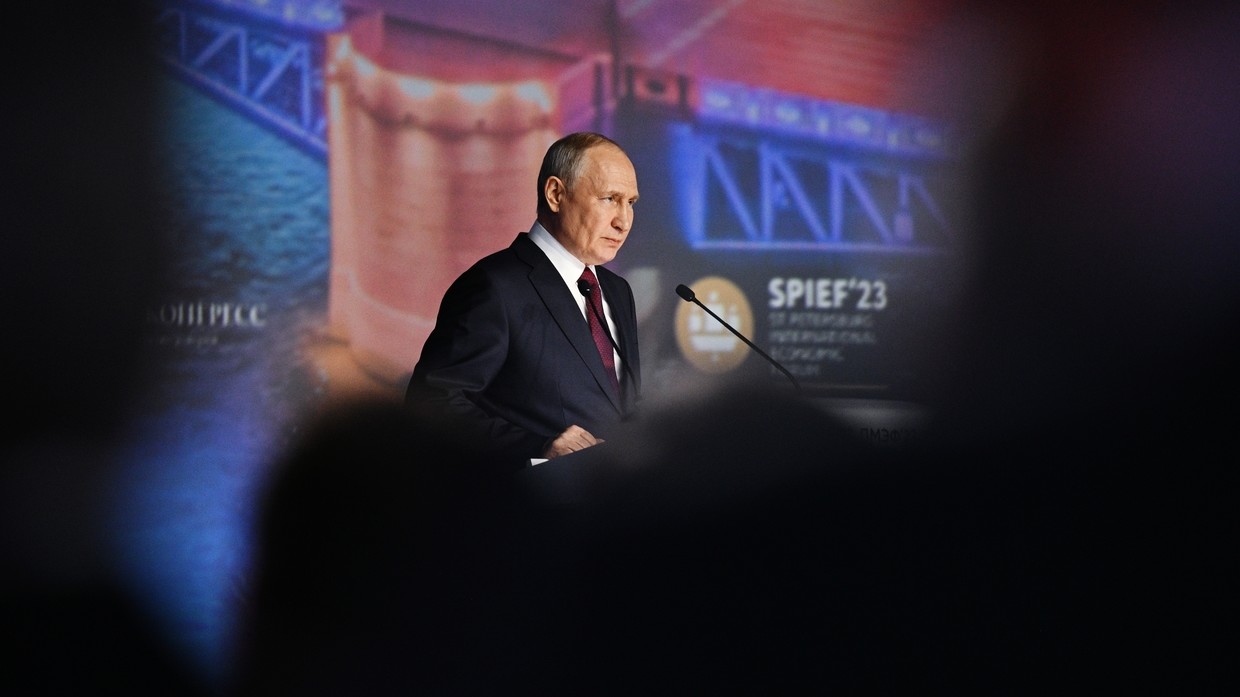President Vladimir Putin was asked again last Friday at the St. Petersburg International Economic Forum about Russia’s nuclear strategy. Recently, Moscow began to deploy nuclear weapons in Belarus. Meanwhile, domestically, a public debate has started over the possibility of a first use of nuclear weapons against NATO in the context of the ongoing proxy war in Ukraine.
Putin’s answer brought no surprises. In summary: nuclear weapons remain in the toolbox of Moscow’s strategy, and there is a doctrine that stipulates conditions for their use. Should the existence of the Russian state be threatened, they will be used. However, there is no need to resort to such instruments currently.
For all the expectations in the United States and Western Europe that Russia will suffer a strategic defeat in the conflict – the Pentagon’s stated goal – Putin doesn’t believe things are moving in that direction. The long-awaited and much-advertised Ukrainian counter-offensive is spluttering so far, resulting in heavy losses for Kiev. The Russian military, for its part, has learned from past mistakes and is holding firm.
Western deliveries of artillery systems, tanks, and missiles, which Ukrainians hoped would turn the tide of the war, have failed to make a decisive impact. According to Putin, Russia has managed to almost triple its production of arms and munitions and is gathering momentum. Meanwhile, Ukraine’s once-powerful defense industry has been all but destroyed.
After the failure of both Russia’s and the West’s initial moves to achieve a quick victory last year, both sides have settled for strategies of attrition. The US and its allies have banked on tightening economic sanctions on Russia, trying to orchestrate the political isolation of Moscow, and hoping that domestic disgruntlement will rise due to multiple daily privations and mounting war casualties. In principle, this is the obvious strategic approach in a long war, where success is achieved not so much on the battlefield as by undermining the enemy’s rear.
The problem for the West is that this strategy isn’t working. Russia has found ways not only to reduce the effect of Western restrictions, but has used them to revive and stimulate domestic production. Indeed, the sanctions have done what many considered impossible: they jolted the country’s economy out of the well-trodden path of oil and gas dependency. Russians are re-learning to manufacture what they once could but no longer bothered with – passenger planes, trains, ships, and the like, not to speak of garments and furniture. The Russian government has set sights even higher, toward regaining the level of technological sovereignty that was abandoned in the wake of the Soviet Union’s demise.
Political isolation from the West has weaned Moscow from its traditional fixation on Western Europe and North America and pushed it to discover the wider world of the dynamic non-Western nations. It is not just China and India and the rest of BRICS, but also the United Arab Emirates, Saudi Arabia, Iran and Turkey. Last weekend in St. Petersburg, Putin shared the platform with the president of Algeria and received a peace mission of six African leaders. Next month, he is hosting a second Russia-Africa summit there. Since the beginning of the year, Foreign Minister Sergei Lavrov has made three trips to the continent, visiting a dozen nations in total.
In the run-up to presidential elections next spring, Russia’s domestic scene is generally calm. Putin is yet to announce his candidacy, but he looks as comfortable as ever, managing war and peace at the same time. Putin has rejected the option of putting the country on a war footing by means of economic mobilization and autarky, general mobilization and martial law or suspending elections and ruling by a version of Stalin’s wartime State Defense Committee. Instead, he has carefully cultivated the image of calm and normalcy across the country, while confronting the population with the reality of a just war on its border.
The population has largely adapted to this split reality. More people, according to public opinion polls, now believe that Russia is winning the war. The fears of a wider mobilization have subsided, and some of those who left the country in a hurry last year are coming back. The rifts and crevices that many observers even recently saw in Putin’s camp, e.g., between the Ministry of Defense and the Wagner Private Military Company, have been closing, clearly on the president’s orders. The liberal opposition can only operate from abroad, which gives more credence to the Kremlin’s argument that they are in cahoots with foreign powers that supply weapons to kill Russian soldiers.
Spectacular provocations from the Ukrainians – such as making incursions into the Russian region of Belgorod, and shelling border towns and villages, sending drones to Moscow and other cities deep inside the country, and assassination attempts on prominent Russian figures – while raising questions about the holes in the Russian domestic security system, have, on balance, strengthened the Kremlin’s case that the current regime in Kiev cannot be tolerated.
Moscow's emerging long-war strategy seeks to play to Russia’s strengths while exploiting Ukraine’s vulnerabilities and the West’s limitations. The Kremlin appears confident it can rev up its war industry and still be able to provide for both guns and butter, raise more soldiers through contracts, and fully use its advantages in aircraft and artillery, while closing the gaps in drones and communications. It also expects that Ukraine’s far higher casualty rate and its soon-to-become apparent disappointment in its ability to counterattack, despite all the assistance it gets from the West, will sap the population's confidence in Kiev's current leadership, most notably personified by President Vladimir Zelensky. The grinding war weighs much more heavily on Ukraine than on Russia.
As for the West, it repeats the mantra of supporting Ukraine as long as necessary. The Russian strategy assumes that when Kiev collapses, it will no longer be deemed necessary. Apart from that, Russians believe that there are two things that Americans and West Europeans are really afraid to countenance. One, mainly as far as the latter are concerned, is a direct collision with Moscow's army, which would turn the Ukraine conflict into a full-blown Russia-NATO war. Given the disparities of power, such a war is unlikely to stay conventional for long, leading the Kremlin to reach for the nuclear option that its doctrine provides for in this case. Two, particularly for the Americans, is the possibility of a European war provoking a Russia-US nuclear exchange that would destroy the world.
Effective deterrence usually combines certainties with uncertainties. The certainty of an adversary’s capability to pose an unacceptable threat, and the uncertainty as to the exact measures that it would take if provoked. The US strategy vis-à-vis Russia in Ukraine has been that of pushing the envelope farther and farther, by upgrading step by step its military support for Ukraine and probing Russian reaction to each stage of escalation. So far, it seems for Washington, so good. Beyond a certain point, however, such practice may turn this calculated strategy into Russian roulette. The proposed arrival of the F-16s and the potential delivery of longer-range missiles would bring the situation closer to that point. Hence, Putin’s confirmation that the nuclear option, while unnecessary at this stage, is not off the table. Indeed, no nuclear power would likely agree to be defeated by another without exercising the ultimate option.
However, let's circle back from doomsday scenarios to where we are today. The Kremlin strategy, it appears, is to chart a middle course between those who would like to freeze the conflict while fixing the gains on the ground, and those who propose to escalate to a nuclear first use as a path to victory. Unlike those two approaches that seek an early result, the actual course that one can trace with the naked eye (who knows what is hidden from view?) is that of a long-term grinding engagement, leading to Russia ultimately prevailing due to its greater resources, resilience and willingness to make sacrifices than the West. Like all strategies built on staying power, this one will be tested at home as much as on the frontline.



